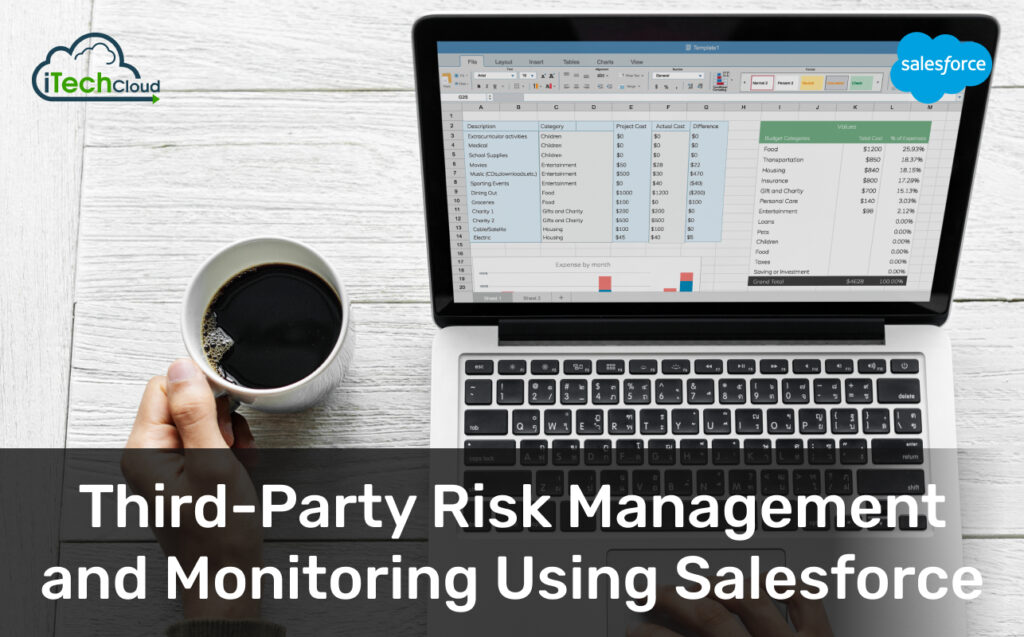Third-Party Risk Management and Monitoring Using Salesforce

In today’s globally connected and cloud-first business environment, organizations rely heavily on third-party vendors, partners, service providers, contractors, and consultants. While these relationships are essential for scaling and specialization, they also introduce significant risks, including data breaches, legal violations, operational failures, and reputational damage.
Third-party risk management (TPRM) is a strategic function that ensures external entities don’t become the weakest link in a company’s risk posture. While many organizations still rely on spreadsheets, emails, or siloed systems for vendor risk management, these methods are neither scalable nor secure. Enter Salesforce, a platform known for its CRM prowess but increasingly recognized for its robust risk management capabilities.
In this blog, we’ll explore how Salesforce can be leveraged to manage and monitor third-party risks effectively, ensuring compliance, continuity, and confidence.
Table of Contents
What is Third-Party Risk Management (TPRM)?
Third-party risk management is the practice of identifying, assessing, mitigating, and continuously monitoring risks posed by external entities that provide goods or services to an organization.
Key risk categories include:
- Operational Risks: Service disruptions, performance failures.
- Cybersecurity Risks: Data breaches, malware, system compromise.
- Regulatory Risks: Non-compliance with industry standards (e.g., GDPR, HIPAA).
- Reputational Risks: Negative publicity from third-party missteps.
- Financial Risks: Vendor insolvency, hidden liabilities.
The goal of TPRM is to ensure that the organization maintains control and visibility over vendor behavior, contracts, data access, and compliance commitments.
Why Use Salesforce for Third-Party Risk Management?
Salesforce, as a cloud-based and extensible platform, provides a centralized environment where organizations can manage all vendor-related risk activities. Here’s why Salesforce is a smart choice:
1. Unified Data Platform
Salesforce can serve as a single source of truth for all third-party vendor profiles, risk assessments, contracts, compliance statuses, and performance metrics.
2. Workflow Automation
Salesforce Flow, Process Builder, and Apex automate repetitive tasks like assessments, approvals, reminders, and escalations.
3. Customizability
You can build custom objects, fields, and logic tailored to your risk framework whether you manage vendors, contractors, or cloud providers.
4. Analytics & Reporting
Dashboards, reports, and AI-powered insights help track performance, flag anomalies, and drive informed decision-making.
5. Third-Party Collaboration
With Salesforce Experience Cloud, vendors can securely submit data, respond to assessments, and monitor their compliance performance in real-time.
The Third-Party Risk Lifecycle in Salesforce
1. Vendor Onboarding and Risk Profiling
The TPRM process starts with onboarding, where Salesforce can help collect and validate the necessary information:
- Capture Vendor Details: Contact info, business category, certifications, and jurisdictions.
- Due Diligence Workflow: Automate KYC/AML checks and background investigations.
- Initial Risk Assessment: Use predefined criteria to calculate a risk score (e.g., financial health, geographic exposure, data access level).
Example: A Salesforce Flow guides procurement teams through onboarding, sending tasks to compliance and IT security for document verification and approvals.
2. Risk Assessment and Scoring
Salesforce allows organizations to assess risk using scorecards and rating models. These can be automated or manual based on
- Data sensitivity levels
- Legal and regulatory requirements
- Business criticality
- Cybersecurity exposure
Vendors can be assigned dynamic risk scores based on assessments and performance.
Integration Example: Integrate with BitSight or Security Scorecard via APIs to auto-import vendor security ratings into Salesforce.
3. Documentation and Policy Compliance
Salesforce serves as a secure repository for:
- Vendor contracts and SLAs
- Compliance documentation (e.g., SOC 2, ISO 27001)
- Data processing agreements (for GDPR)
- Audit logs
You can use Salesforce Files or integrate with e-signature tools like DocuSign to streamline document management.
Alert Setup: Use workflow rules to notify stakeholders before certification expirations or contract renewals.
4. Ongoing Monitoring and Performance Management
TPRM doesn’t end after onboarding. Continuous monitoring is vital.
Salesforce can:
- Trigger alerts on SLA breaches or incidents.
- Track service uptime and issue resolution time.
- Visualize KPIs in performance dashboards.
- Log and score risk events for trend analysis.
Use Einstein Analytics for forecasting risks based on historical patterns.
Real-World Use Case: A company sets up Salesforce to automatically downgrade a vendor’s risk rating if they miss 2 SLAs within a month and notify the legal and procurement teams.
5. Third-Party Portal (Experience Cloud)
Vendors often delay assessments due to email overload and confusion. With Salesforce Experience Cloud, you can build a dedicated vendor portal.
- Vendors update certifications and attestations.
- Respond to compliance questionnaires.
- View their risk scores and performance KPIs.
This promotes transparency, reduces administrative burden, and accelerates collaboration.
6. Incident Management and Escalation
When a third-party incident occurs, such as a data breach or supply disruption, Salesforce can manage the entire incident lifecycle:
- Log the incident and categorize it.
- Assign an owner and resolution deadline.
- Track corrective actions and post-incident reviews.
- Escalate high-impact events automatically to executive dashboards.
Security Response Workflow: A triggered alert notifies the CISO and compliance officer when a vendor is impacted by a cyberattack, initiating a full risk reassessment.
7. Audit Trails and Compliance Reporting
Salesforce’s built-in logging and analytics allow organizations to:
- Maintain audit trails of every vendor interaction.
- Demonstrate compliance to regulators.
- Create real-time dashboards for internal and external audits.
- Export risk logs for board reviews.
Salesforce Shield enhances this with field-level encryption, event monitoring, and advanced auditing capabilities.
Tools and Integrations to Extend Salesforce for Third-Party Risk Management
- Salesforce Shield: For data encryption and compliance auditing.
- Onboarding and KYC Apps: Available via AppExchange.
- GRC Tools: Integrate Salesforce with LogicGate, RSA Archer, or ServiceNow GRC.
- Security Ratings Platforms: Integrate with BitSight, UpGuard, or SecurityScorecard.
- Legal/Contract Management: Use Conga or Ironclad for contract automation.
- Data Enrichment: APIs from Dun & Bradstreet and LexisNexis for vendor verification.
Best Practices for Implementing TPRM in Salesforce
1. Start with a Risk Framework
Define how your organization measures risk: key factors, thresholds, and tolerance levels
2. Standardize Data Collection
Use consistent templates and forms to capture vendor data.
3. Automate the Lifecycle
Use flows and automation rules to reduce human error and speed up assessments.
4. Enable Real-Time Dashboards
Visualize active risks, expiring contracts, and vendor statuses.
5. Educate Your Teams and Vendors
Provide training for internal users and offer guidance to third parties using your Experience Cloud portal.
6. Review and Improve
Regularly update risk models based on industry changes and incident history.
Real-World Case Studies
✅ Financial Institution:
A bank integrated Salesforce with its compliance tool to automate vendor onboarding and monitoring. Results:
- 60% reduction in onboarding time
- Automated reminders for contract reviews
- Risk dashboards accessible to compliance and legal teams
✅ Healthcare Provider:
A U.S.-based hospital network used Salesforce to manage third-party HIPAA compliance. They created a vendor portal for document submissions, training certifications, and assessments, resulting in:
- Improved audit readiness
- Faster re-certification cycles
- Complete visibility into third-party access to patient data
Challenges and Considerations
- Customization Complexity: May require developer support or consulting partners.
- Data Governance: Ensure strict controls over who can access what.
- Integration Effort: Syncing Salesforce with legacy ERPs or compliance tools may need upfront investment.
- Change Management: Encourage adoption through training and communication.
Conclusion: Third-Party Risk Management and Monitoring
Managing third-party risk is no longer optional; it’s a business imperative. With Salesforce, organizations gain a powerful and flexible platform to manage the entire vendor risk lifecycle from onboarding to offboarding, with real-time visibility, automation, and compliance tracking.
By integrating Salesforce into your third-party risk management strategy, you future-proof your organization against emerging risks and ensure that your extended enterprise operates securely, efficiently, and in alignment with your risk appetite.

